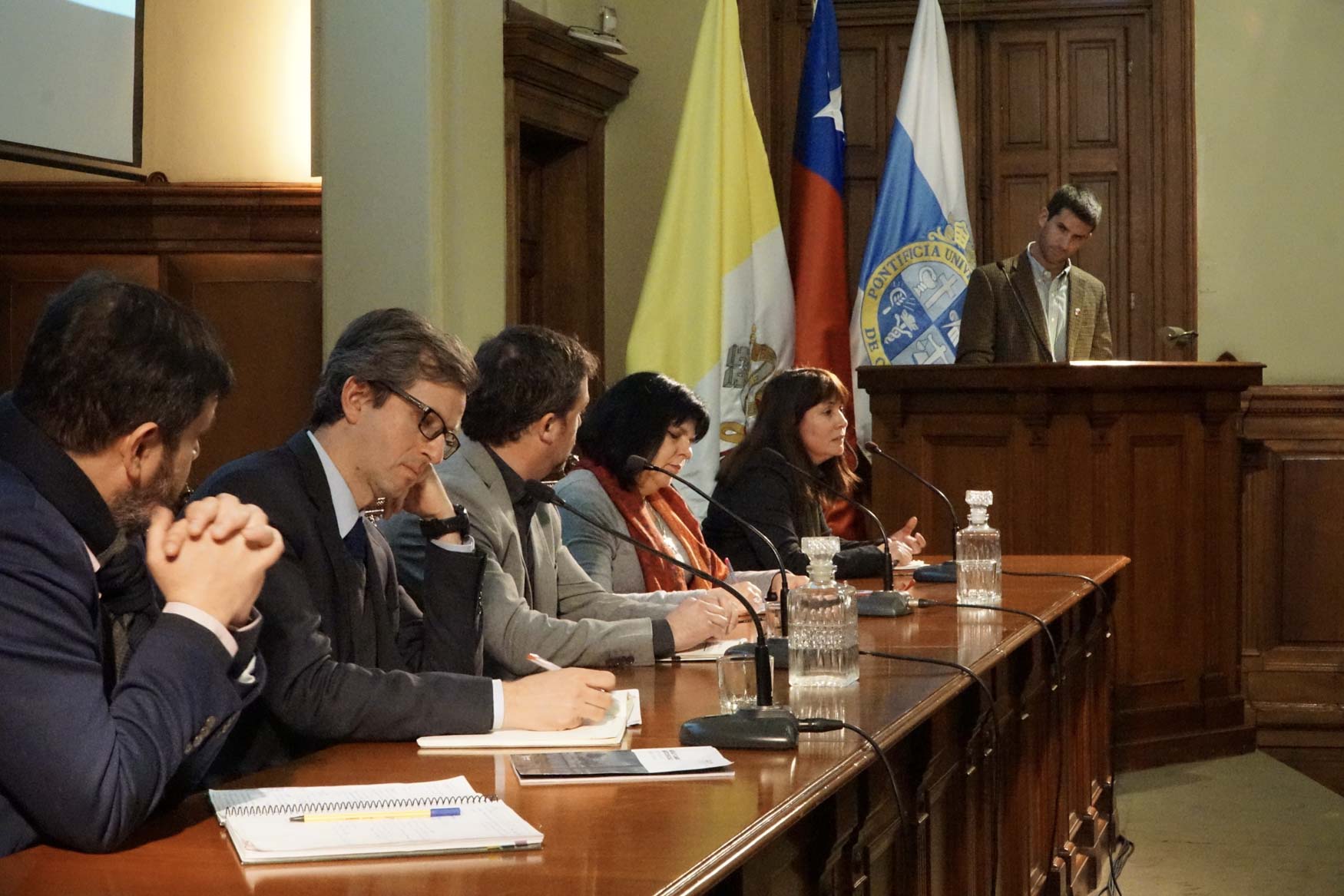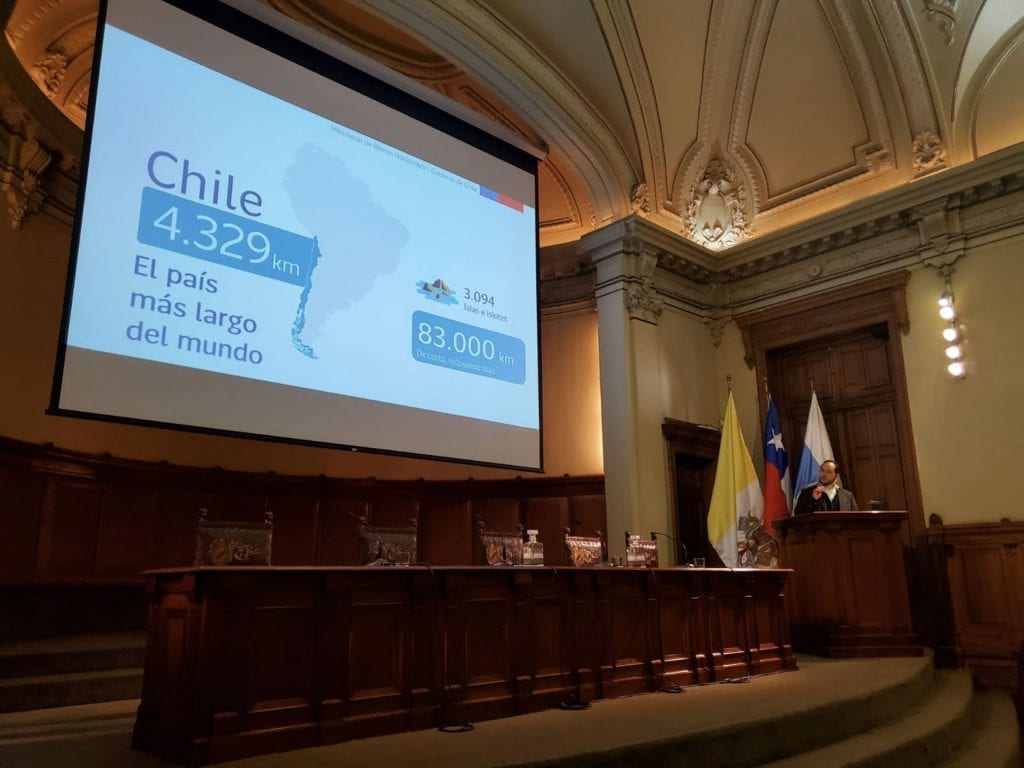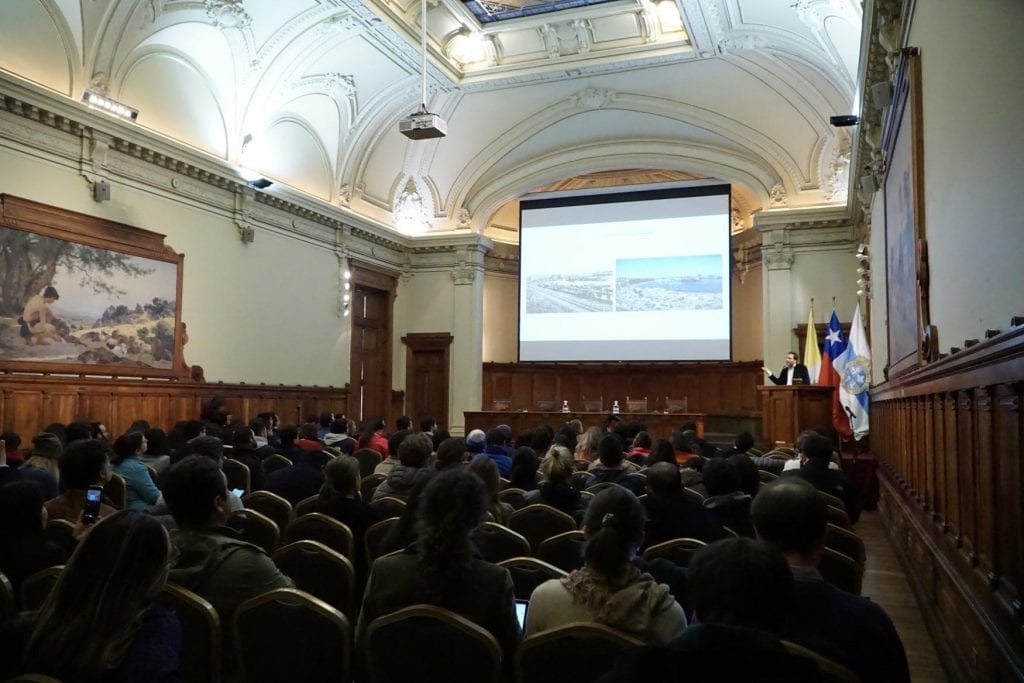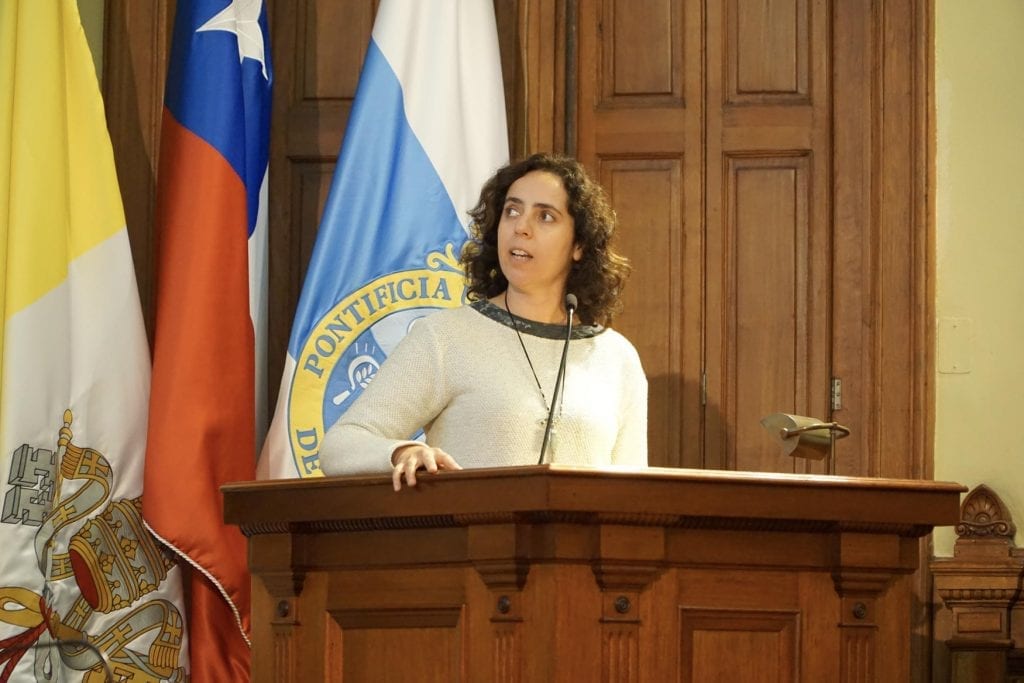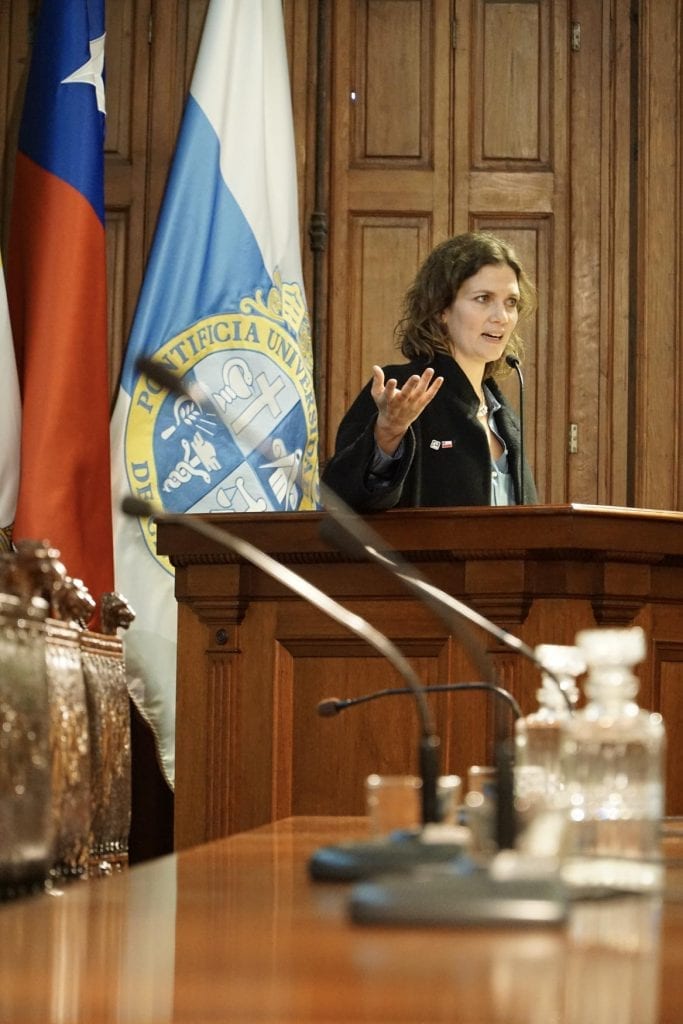Seminario Borde Costero Agosto 2019
“Coastal Edge Seminar”, discussing aspects for integrated management
With the participation of authorities and specialists, the activity organized by Chile-California Council took place, with the purpose of covering different topics that will allow an adequate work in the legislation of the coastal edge in order to achieve a sustainable development in its natural processes. We invite you to read more about this seminar.
With the participation of the Ministries of Defense, National Assets, Science, Environment and Foreign Affairs, as well as representatives of social and scientific organizations, the activity organized by Chile-California Council “Coastal Edge Seminar” was held in the Hall of Honor of Casa Central of the Catholic University of Chile. From all the public-private viewpoints, the main aspects to develop an integrated management in the legislation of the coastal edge were covered, correlating all the current instruments and the different multisectorial and interdisciplinary visions that intersect. The seminar was sponsored by COP25, Ministries of Environment and Foreign Affairs, Resources Legacy Fund, Center for Applied Ecology and Sustainability CAPES UC, and as main media partner Ladera Sur.
This activity is developed in the framework of emphasizing the importance of knowing how the coast is managed and what happens in it, as well as knowing what are their interests of use and places of high biological value. Kaitilin Gaffney, Director of Oceans, Coasts and Fisheries at the Resources Legacy Fund of Sacramento-California, who was key in the process of creating the network of Management and Protected Areas along the entire coast of California, through the Marine Life Protection Act (MLPA), participated in the event.
“The process in California was not easy at all and took a long time. The coast was divided into sections and progress was made in each one in stages, bringing together all the actors involved in the coastline, such as fishermen, industry, tourism, real estate, local government, and in this way, together with all the scientific information as a basis for discussion, agreements were reached. The final application resulted in a positive biological and socio-environmental balance, and in many cases not everyone was happy. However, after almost 10 years of information gathered since its implementation, the results have been amazing in terms of marine biodiversity, as well as in terms of the fishing economy due to the high recovery that the protected areas have provided” – commented Kaitilin Gaffney about the experience in the coastal zone of California.
The event counted with the participation of different authorities and scientists who were ready to expose about the different matters that surround the coastal edge, emphasizing the importance of a regulation that allows a sustainable development of all the natural processes and economic and social activities in the coastal edge, since Chile has a unique coastal reality, which extends for more than 83 thousand kilometers of linear coastline.
The Coastal Edge is legally defined in our country since 1960 under the decree with force of law number 340, which is the current regulation of maritime concessions and where the Ministry of National Defense is given the responsibility of control, supervision and oversight of the entire coast and territorial sea, as well as rivers and lakes.
After 30 years, in 1994, the National Policy for the Use of the Coastal Edge (PNUBC) was established in DFL 475, which recognizes the integrated and systemic nature of the terrestrial and maritime coastal zones in order to achieve a harmonious development of the coastal edge. Among its objectives, the PNUBC proposes the preferential uses of the coastal edge through macro and micro zoning to establish territorial planning instruments, all this through the Regional Commission for the Use of the Coastal Edge (CRUBC) and the National Commission for the Use of the Coastal Edge (CNUBC).
“Today, at least as of 2017, we have around 3,400 maritime concessions granted along our coastal edge. They are especially concentrated in the far north and in the central and southern areas where there is more interest in applying for permits that allow you to see this area that all Chileans are supposed to have access to” states one of the first exponents, Cristian García- Huidobro Head of the Legal Division of the Ministry of National Defense.
The draft Coastal Edge Law – introduced in 2012 and approved in its first constitutional procedure but which has remained stranded until today – seeks to transfer the administration and coordination of the use of the coastal edge to the Ministry of Social Assets and to establish a new regime of maritime concessions.
According to what is established in the bill, the coastal edge presents a complex legal nature that integrates both national public use assets and fiscal assets, currently subject to control, supervision and oversight, so it is necessary to have a regulatory regime for maritime concessions that allows greater speed in its processing and better ensures legal certainty for its holders, considering the environmental, social and economic aspects that converge in the coastal edge.
In this case, it is pointed out that it is a better alternative to hand over the management and establishment to a body with a territorial vocation such as the Ministry of National Assets, and to give it the powers of coordination of the other public entities with competence in the Coastal Edge, in order to promote the development of this area in a sustainable and harmonious way.
“In this context of a diverse territory that we have and where there is a relevant role of the State from the point of view of management, the Ministry of National Assets has as its mission in the service of the country the territory of all to use it in a sustainable way and as an engine of development, economic, social, cultural and environmental of the country” exposes Sebastián Seisdedos, Head of Heritage Unit of the Ministry of National Assets who also adds that the need for a Law lies in that there is a more updated, comprehensive and articulated vision of the interior coastal territory of its national policies, its planning and its management.
“The opportunity that the bill provides is interesting because it allows in some way to order these three components: planning component, management component and integrated of the territory, beyond its administrative limits (…) Also because if we look, we are talking about a regulation that is more than 60 years old and evidently in 60 years we have changed the way in which we understand things and also the procedure according to which a more modern State approaches the management problems”, he comments.
According to what Seisdedos pointed out, the bill considers three objectives: the first one consists of regulating the process of fixing and modifying the national policy of the use of the coastal edge, placing it in the Ministry of National Assets.
The second corresponds to the process of zoning of the coastal edge, throughout the national territory, in those areas that are not already regulated by a territorial planning instrument, establishing preferential uses that make it possible to make the rights of individuals compatible with the needs of the community and the country.
Finally, a new maritime concessions regime is established to improve efficiency and speed in the granting, renewal, modification and transfer of maritime concessions with greater legal certainty.
After the introduction of the political framework of the coastal edge, the keynote speakers were introduced. Diego Urrejola of Fundación Cosmos spoke on behalf of the new Coalition of Chilean NGOs working on the coast called Costa Chile, which was created to accompany the government in the process of the coastal edge law to ensure that the appropriate technical elements for an integrated management of the coastal edge are considered, a design that is resilient to the effects of climate change, that considers the safeguarding of areas of high biological value, and that contemplates a comprehensive land use planning on all existing uses and pressures on the coastal edge, to ensure a prosperous development on the coast for Chile, a country that is coastal dependent on all sides.
Giving concrete facts about the experiences of the NGOs that make up Costa Chile – Fundación Mar Adentro, Punta de Lobos, Rompientes, Cosmos, Global Nomad and Geute Conservación – Diego Urrejola set out to contrast in his before and after, different buildings and projects throughout the country that have been built on the coastal edge and dunes, and the repercussions they have suffered on the infrastructure and the population that lives there, due to the effects of rising sea levels and climate change. “How many additional ecosystem services are we willing to lose to understand that we must protect them because they protect us?” he asks the audience. “We are all familiar with the case of Avenida Peru in Viña del Mar, or that we continue to build in areas that were – recently – flooded by the tsunami in 2010, to mention a few examples.”
He also stated, “What is worrying about the new legislation has to do with its objectives. When we have a policy and a regulation that is mainly oriented to concessions and that is not oriented to the management of all the qualities and characteristics of the territory – for whatever reason – it is worrying. Zoning is not the same as managing and managing is not the same as administering, they have different intentions”, affirms Urrejola.
On the other hand, Felipe Paredes and Claudia Silva gave a presentation on the GEF (Global Environmental Fund) Project of the Ministry of the Environment, on the Governance of Marine Ecosystems and Coastal Wetlands. They discussed the main threats currently facing marine ecosystems, and how these GEF programs can improve the ecological and conservation status of coastal ecosystems. Claudia Silva highlighted, based on concrete examples of work in different wetlands in Chile, how additional sites of high biological value can be added under this work mechanism established by the Ministry of the Environment, allowing the creation of a network – for example – of coastal management and protected areas, as was done in the case of California.
The activity also included the participation of Laura Farias, Head of the COP25 Oceans table and Principal Researcher of the Coastal Zone of the Center for Science, Climate and Resilience CR2 of the University of Chile, who gave a vision of how Chile has been preparing for COP25, in the sense of the relevance given to the scientific sector for the coordination of issues. He emphasized that this COP has allowed Chile to make substantial progress in the validation of science to support processes and decision-making based on science.
In the same logic, the Undersecretary of the Ministry of Science, Carolina Torrealba, highlighted the work of the Chile-California Council in organizing this meeting, which brought together the views of multiple ministries and disciplinary sectors.
“The creation of the Ministry of Science is a gigantic structural advance for Chile, and over time it will take the necessary space for academics and scientists to achieve a much greater degree of influence in the legislative and governance processes, with science used as a basis of support and context that is transferable to the social and environmental feasibility of implementation,” said the Undersecretary. She also added, “the example we have in Las Cruces with the protected area without extraction promoted by Professor Juan Carlos Castilla, has given resounding results after almost 20 years studying an area that was left free of any type of intervention. Examples like this are highly replicable throughout Chile, and you can count on the Ministry of Science being part of the discussion in the work of the coastal edge of Chile, which is very challenging, has several complexities and is long term. Having the example of a similar case that was successful, as in California, is a great opportunity to apply the lessons learned.”
Finally, the seminar concluded with a panel discussion composed of Diego Flores, Head of the Department of Protected Areas of the Ministry of Environment; Cristián Pérez Executive Director of Global Nomad; Flavia Liberona Executive Director of Fundación Terram; Carolina Martínez, Geographer specialized in Coastal Evolution and Associate Researcher of CIGIDEN, and; Juan Ibañez, Founder and Director of Corporate Sustainability of the UC Law Dean’s Office.
In this space Matías Alcalde, representative of the Chile-California Council, opened the session with the question “How do we continue?” He highlighted all the presentations of the day, which exposed much of the political, legal and technical context, in addition to the vision of California, on the challenges facing the country in this area. At the same time, he explained the opportunity that Chile has with everything that is happening, to prioritize in its agenda the discussion on the Coastal Edge.
“The COP25 in December, the creation of the Chilean Ministry of Science necessary for a management process like this, the possibility of connecting from North to South the entire biological-coastal corridor of the Pacific Ocean if Chile advances as California did, the fact that Chile is chairing the Pacific Alliance, the process of the Coastal Border Law in process, the GEF programs of the Ministry of Environment, etc. All opportunities that allow – in the case of Chile – to anticipate a necessary conversation that in other contexts would be difficult to promote and create wills to advance in this key issue for Chile, as a country dependent on its coast. This conversation has multiple discourses depending on the target audience, and undoubtedly in the long run it generates benefits for all parties.”
The panel discussion was held in this logic, where the diversity and representativeness of its members highlighted the breadth of views. It was analyzed from the legal instruments available from the government, to the technical considerations in the sense of climate change and biodiversity protection, as well as social in the sense of welfare and process required for implementation, economic to understand the uses, pressures and benefits of land use planning and coastal zoning.
“The coastal edge issue is being a topic that is being positioned in the environmental agenda of the country and I think we must be optimistic. However, we have many challenges. The first begins with understanding that Chile is a country that is highly vulnerable to the effects of climate change, and therefore, looking at it from that perspective requires us to have an integrated understanding of how we are preparing for those effects. If we do not take charge in time, it will be much more costly to repair bad decision making, many of them irreparable. As Chile, we are in time but we must move forward on this issue urgently. The population will only increase in coastal areas in the coming years and it will do so considerably, Chile is a country that depends on its coast”, emphasizes Flavia Liberona.
